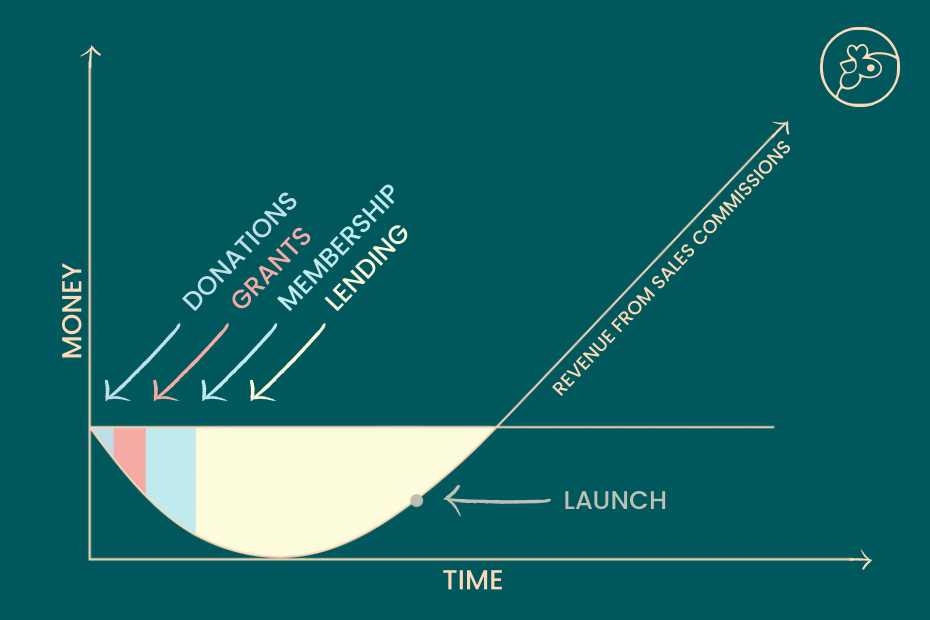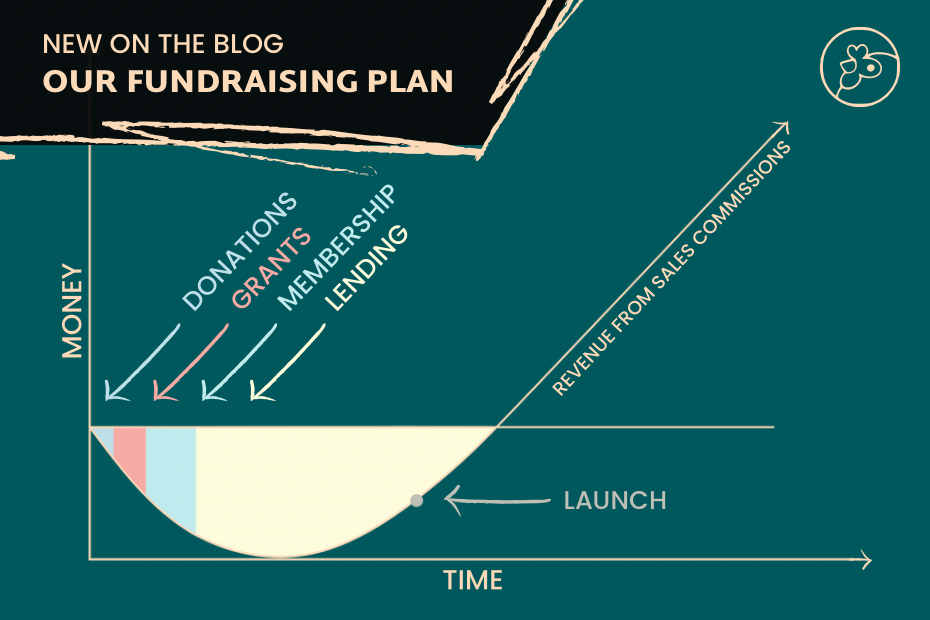Updated 9/8/23.
Since July 2022, we’ve been building the tools we need to develop a cooperatively-owned handmade marketplace. In this post, we’ll discuss how we’re going to pay for it all with our 5-stage fundraising plan.
We created this plan with guidance from our co-op advisors at Start.coop and this excellent article, the Co-op Financing Playbook.
What We Need Funds For
First, let’s recap everything we did in our first nine months with about $1,000 in donations and a passionate team of volunteers:
- Grown a community of nearly 1,500—including subscribers to our email list and a vibrant forum on Discord.
- Polled our community four times and incorporated their responses into the design of our plans and policies
- Finalized our 2023 work plan, marketplace tech plan, ownership model, and handmade policy and presented them all in Open Houses
- Hired a lawyer, filed the articles of incorporation, and drafted the bylaws
So, what comes next? The most critical (and expensive) pieces of the puzzle: enacting all the plans and policies we’ve made together.
Build the Marketplace
We’re using cost-efficient and secure existing e-commerce technology from Shopify rather than coding from scratch. This will save us time, money, and uncertainty. Nonetheless, we intend to hire a professional Shopify developer who knows the technology well. We plan to roll out the marketplace in phases, each with a larger number of artisans.
Estimated cost: $25,000-$30,000
Develop and Execute a Robust Marketing Plan
We believe the future success of our marketplace lies in our ability to attract a critical mass of artisans and shoppers. Building both audiences presents a “chicken-or-egg” dilemma: how to get shoppers without a lot of products to shop, and how to get a lot of artisans and products with only a few shoppers. We’ve decided to follow ShareTribe’s advice and focus on artisans first, shoppers second.
If funded in full, our marketing plan will include content, social media/influencers, digital advertising, email, a printing and travel budget for grassroots outreach, designers, and advisors.
Estimated cost $100,000-$120,000
Hire Staff
Ideally at least two: a marketing person and a technology person. Staff will execute our plans, lift the burden off volunteers, amp up our professionalism, be our first worker-owners, and create awesome jobs.
Estimated cost $100,000-$125,000
All together, that totals about $250,000. So, how are we going to pay for all of this?

Our 5-Stage Fundraising Plan
We’ve already done some successful fundraising, but we’re ready to take it to the next step, and make this a reality. To do so, we have a five-stage strategy for raising the funds through a combination of sources.
This is our fundraising plan in 5 stages:
Stage 1: Donations / Fundraisers
We began our fundraiser in October 2022, accepting donations through our Paypal site and Ko-fi page, and from artisans via a mutual-aid physical goods fundraiser. In 6 months, this raised approximately $2,000, which we’ve been using to pay for operational expenses, like email and social media scheduling software, domain hosting, etc.
Stage 2: Grants / Business Competitions
We’ve researched, found, and applied for dozens of grants and business competitions. So far, that has resulted in a $10,000 grant from the Start.coop 2023 Spring Accelerator, and we’re continuing to find additional opportunities to apply for. We’ve used those funds to pay for the legal expenses of business incorporation.
Stage 3: Member Investments
Memberships are critical for two reasons:
1) they provide quick and early funds to pay for the website
2) they provide leverage for greater capital from lenders
Just like partnerships but with a lot more members, it is typical of member-owned businesses to pool their funds to get the cooperative off the ground. We are beginning a member capital campaign this spring to raise $25,000 for the marketplace tech plan / website development.
The member drive comes before financing because lenders need to see that we’ve raised the beginning stake ourselves before they’re willing to finance us. Memberships prove to bankers we have traction, momentum, and commitments.
Stage 4: Financing
Update September 2023: After successfully raising $50,000 in memberships during our first two months, the membership voted to “bootstrap” our way to success rather than rely on significant outside financing. We may still pursue some cooperative-friendly financing after our launch, such as friends & family loans or bank loans, but are not seeking outside investors.
Loans could come from a variety of sources, and we have a list of leads from our advisors at Start.coop. They could come from co-op friendly funders like Shared Capital Collective, or crowd-sourced through a platform like Kiva. Our membership capital and website revenue would provide leverage for any debt financing.
Stage 5: REVENUE!
As soon as we launch our marketplace, artisans will begin having sales, and the co-op will begin earning a sales commission. Those sales commissions will:
- Hire staff and pay for marketing
- Pay off our debt
- Build up a rainy-day fund
- Improve our marketplace
- Pay expenses going forward
- Be returned to co-op members as dividends when there’s a surplus
Next Steps
We’ve made solid progress on Stages 1 and 2, and we have more momentum than ever. We will continue to work on Stages 1 and 2 as we begin the third stage: Member Investments.
Member investments are the most critical: we need artisans on board to prove their interest. Not just for bankers, but for ourselves. We need to see and hear each other and band together. We know this is our best chance to get off Wall Street and take back control of our livelihoods.
You’ll be hearing from us in the next few weeks as we launch our first Member Capital Campaign for early founders. Get ready!
What do you think about our fundraising plan? Share your thoughts in the comments below or contact us.
About Artisans Cooperative
We are growing an online handmade marketplace for an inclusive network of creatives: a co-op alternative to Etsy.
Shop the marketplace!

I’ve been following your emails and am interested as an artisan.
I’m still a little confused about the “member-owned” business. Is this an option for an artisan or is this a requirement to sell as an artisan on your platform?
If I become a “member” what does this entail in terms of time/finances etc?
I love this idea you are developing and want to be a part of it.
Your goal is to raise member funds of $25,000. Is this amount to be paid and divided amongst the existing members or do members give what they can?
Great questions Beverly, thank you for asking! Our next post will go into this in a lot more detail, but briefly:
– We need some (enough) folks to become early members in order to build the marketplace at all
– However, once it’s built, you do not need to be a member to buy or sell on the marketplace
– Membership benefits and responsibilities are briefly outlined in our Ownership Model Canvas
– Membership costs coming soon in our next post. Each member will contribute the same amount (pooling our funds together), although we will have cash and non-cash ways to contribute. Those funds will pay for website development.
More coming soon! Thank you for your support, Valerie
Pingback: Join Our Founders Circle Before July 31st | Artisans Cooperative
Pingback: Items Needed For Mutual-Promotion Fundraiser | Artisans Cooperative
Pingback: We’ve Doubled Our July Goals With The “Grow The Co-op” Challenge | Artisans Cooperative
I’m interested and plan to be a member. I do have some comments:
1. I think your staffing plan is insufficient. The amount you named is not enough to hire two top notch people in their fields. Remember benefits cost something like 30% of salary. Also, I can’t imagine that one tech person is enough to launch an Etsy-like marketplace. The coop is an online enterprise, meaning techies will be essential to making every idea happen. From years of reading complaints in the Etsy forums about half baked technical chamg
Oops, did not finish my thought and I don’t see an edit button. (An example of the point I’m making.) To finish my sentence, years of complaints in the forums have showed me how hard it is to make an online marketplace with hundreds/thousands/millions of individual shops operate smoothly. You can’t beat Etsy without being better than Etsy, technically as well as in mission, structure, and finances. You need a very strong plan for now you can pull off the technical side of the vision. It can’t be overlooked.
2. For what it’s worth, it’s not the collective nature of your enterprise that grabs me. It’s a lovely idea, but I’m distrustful because of human nature. Leaders will emerge and have greater power because that’s what happens in groups. If you plan to have consensual decision making, get ready for massive wastage of time as one or two people block any movement. Profit sharing amounts to little if there isn’t any profit. And so on. What I like is the idea of starting Etsy over but holding fast to th
Holding fast to the “keeping commerce human” principles. I wonder if you considered a nonprofit marketplace rather than a worker-owned one. That allows you to raise all kinds of money and releases the governing body from the pressure to turn a profit. I don’t actually know if it’s allowable to run an Etsy-like organization as a nonprofit but it would be good to know. I used to run a nonprofit coalition, and the organizational/legal structures of its members had nothing to do with the coalition’s organizational/legal structure. But it was unlike Etsy in many many ways so my experience may be irrelevant.
Anyway, good luck to you! Ad astra per aspera!
Thank you for the feedback, Judith, these are great thoughts.
1. We expect our starting costs to be lower because we’re not hiring engineers. We’re working with existing technology like Shopify, so we’re not coding from scratch. Existing platform technology tools have come a long way since Etsy got started. Our tech person just needs to be tech-savvy and trainable, likely a recent grad. They will be a resource in addition to working with Shopify Experts on a maintenance plan and IT support (also included in the budget).
2. Our founding organizers have experience in nonprofit management. We decided early to form as a cooperative because we wanted a better model. Unlike nonprofits, cooperatives are managed democratically and financially benefit the owners: all of us. A non-profit has no owners, which means in practice that they are often hierarchically controlled by an elite board of directors, just like corporations. We briefly considered a worker self-directed nonprofit, but it didn’t meet our needs for a multi-stakeholder ownership model, it is a legally experimental idea limited to certain states and the legal costs were too high. We wrote a post early on about the difference between union/guilds (nonprofits) and cooperatives/collectives (democratic businesses).
In cooperation, Valerie
Pingback: Now Enrolling Members! Join An Authentic Handmade Marketplace | Artisans Cooperative
Pingback: 2023 Year In Review | Artisans Cooperative